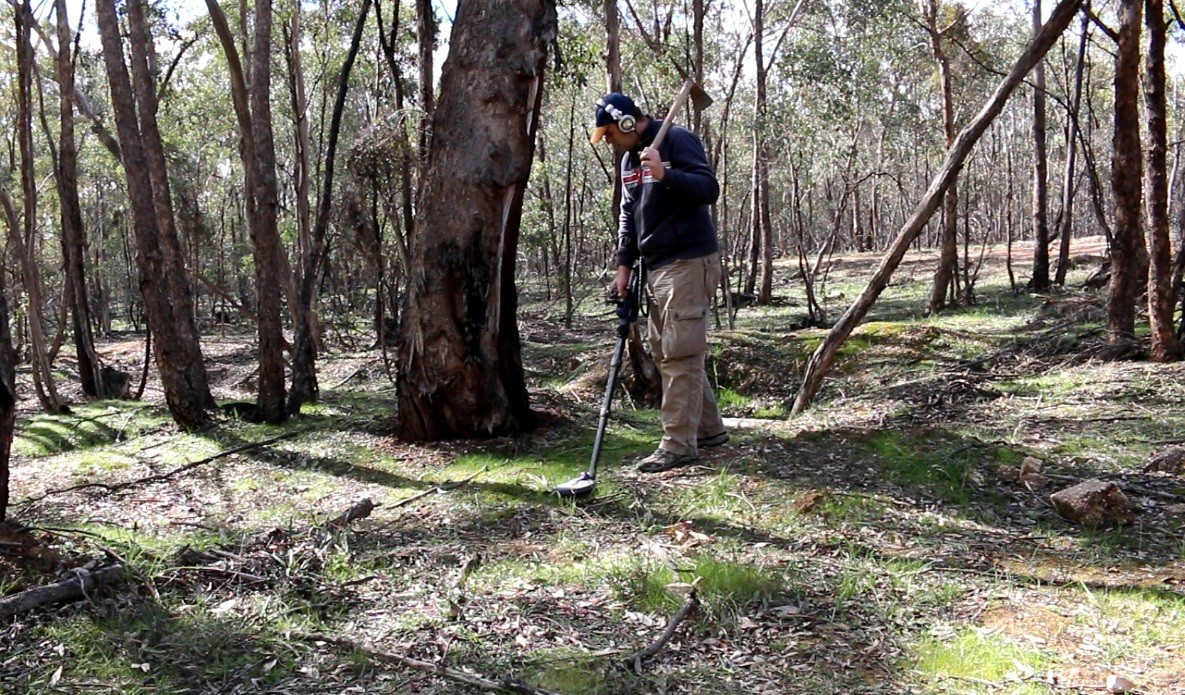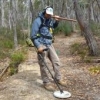-
Posts
616 -
Joined
-
Last visited
-
Days Won
4
Content Type
Forums
Detector Prospector Home
Detector Database
Downloads
Posts posted by PhaseTech
-
-
I haven't used one in the salt yet, but I'm assuming it won't be as good as the Xpointer Pro, as the Pro is Pulse Induction.
-
Yeah the 11" Commander in Enhance should be pretty tame, otherwise Sens Smooth as a last resort.
The other trick you can do is use Tracking and count how many sweeps it takes to track out. Usually noticeably faster to track out a hot rock compared to a nugget, but it's a risky practise.
-
Simon, when people post things like that out of the instruction manual, it gives me weird deja vu reading it, as myself and Ian Aitken wrote a lot of the content for them, with the 5000 manual being about the last one.
-
Fine Gold was a little "faster" than Enhance, so seems to have a small improvement on thin pieces on edge, and some reefy gold. On solid waterworn gold I've never seen any real difference, and sometimes Enhance can even be better, which is why it was left as an option in the 5000.
Re hotrocks, Enhance should be slightly less reactive to the majority of them. I know the more sensitive Flat wind coils run better in Enhance than Fine Gold in bad ground.
-
One thing I've noticed with the 14 DD vs 11" mono, is the depth difference in Difficult vs Normal. Basically, on targets larger than a .22 bullet (very roughly), the 14" DD gets the best depth improvement when in Normal, compared to both the 11" and 17".
The 17" will see a better depth improvement compared to the 11", but only when ground conditions are really mild.
-
It is very effective in High EMI areas, even in the Salt setting.
-
4 hours ago, Steve Herschbach said:
The big difference is when you get into an area with hot rocks a GPX 4500 just can't handle, and a GPX 5000 Fine Gold setting just makes them go away. If it were not for those rocks, and that one setting, a 4500 would do me fine. If you don't have them where you hunt, you'd never know. Unfortunately, it's my biggest problems with both the GPZ 7000 and GPX 6000, and why I'm still looking for that "other PI." Luckily I can just hunt other places rather than get a GPX 5000 or an ATX, both of which solve the problem. I just want a GPX 5000 or ATX in a nice package.... too much to ask?
Really? The 4500 picks them up in Enhance where Fine Gold doesn't?
-
If it can do what the Impact does inland, but with the few benefits on SMF, then it will replace the Impact. If it can get good depth on the beach with a nice solid audio response, even if it means adding the 13" coil, then it may replace a few beach machines.....but we will have to wait and see.
-
So how about a GPX4000 (limited feature set) style machine in a high impact lightweight plastic case, carbon fibre shaft, a small lithium battery built in, but still with the 5-pin socket if you want to plug in an external battery, and a nice lightweight coil in the 6000 11" coil housing. If priced right would it sell?
-
On 11/22/2021 at 9:57 AM, Rob Allison said:
the GPX 6000 is super sensitive, light and easy to use. However, I'm picking up much more ground noise, more EMI and twice as much hotrocks (mostly ironstones and basalts) vs. the GPZ 7000.
I love both detectors, I'm very partial to the GPZ due to all the years I have used it and success with it. The new NF coil really makes it much lighter and a bit more sensitive over the stock 14x13.
I'm using the GPX 6000 for more prospecting and exploring due to the lightweight and increased sensitivity to small gold. If I find a patch or rich gully, I can also pack in the GPZ to check out areas with more depth.
Rob, agree with all these points, the 6000 is very effective, especially when you are dealing with ground that has been gone over time and time again. It's like when the 2300 came out all over again, just with deeper holes.
-
Target ID, push buttons, display, silent threshold, sounds like many modern detectors......maybe it just came out too early and the people weren't ready for it???
-
BBS and FBS machines have always had one key advantage over single frequency detectors, regardless of soil type, and that is accurate ID on large ferrous items. Or, to put it another way, a reduced likely hood of false positive responses on crap you don't want to dig. On the Equinox it really depends where you set your Iron Bias.
But it's not just all SMF machines, as I believe (correct me if I'm wrong) that the early CZ's were notorious for giving good responses on deep iron.
-
I have had a play with this and I am impressed. Very loud, feels great in the hand, good depth. Only received one demo unit and two for stock, and the two stock units went out the door. My demo is out on loan. Battery meter on start up is a nice feature.
-
14 hours ago, phrunt said:
https://www.ja-gps.com.au/Minelab/equinox-800/
Even includes free shipping.
https://www.minersden.com.au/minelab-equinox-800-metal-detector
I know, I don't get into price wars, as there's no end.
-
Equinox 800 RRP here is $1299. The $1050 pricing is heavily discounted.
-
Does anyone know what the iron range will be? 1-10 or 1-20, or slightly different depending on the mode as per Impact.
-
Well this is the first Nokta Makro machine I didn't get to test since the Racer 2, so I'm seeing it with fresh eyes. Several things about the Legend are getting me very excited. Adjustable recovery for one. So I can basically set the recovery speed I want, and with four custom modes, that means I can toggle between two versions of the same mode (hope I interpreted that correctly??).
Gold mode! I have been telling Dilek for years that they need to rename Gen and just call it Gold Mode, as Gen doesn't really mean anything to anyone apart from people already familiar with Nokta Makro machines. If the basics of the all-metal mode match Gold Kruzer but with a 40 kHz operating frequency, it will be very capable, and maybe even more so in bad ground. I mean a 19 kHz fors gold plus with the small 5" coil can still ping tiny gold, so 40 kHz is only going to do better.
The headphones look a little bigger than the Green 2.4 Ghz version, which have always been a little small for my head. Hope I'm right on that, but if not, I'll be using the new Quest bluetooth headphones.
Iron probability FerroCheck thing is a nice addition, and be interesting to see how reliable that is in different soils and different applications. If it can scramble on rusty bottle caps that would be awesome when working picnic areas, or busy beach spots.
Lots of Audio options, and harmonic sounds does sound interesting.
Just need a couple of solid elliptical coil options for the guys who will use this for serious small gold hunting. Would love a 7x4" but as a concentric, and a 10x6" DD (somehow stuffed in the slimline GK 10x6" concentric housing).
On paper, it looks like this can replace the Impact, Gold Kruzer and maybe a couple other machines that I have in rotation, but I'll wait until I get a few weeks of use behind it.
-
If you are never getting any signals from the ground, you may want to try the Normal ground mode, as this will give you a little more depth.
-
My ute has a factory installed 240V outlet on the back of the centre console, so all my mains chargers work. Also handy for when my son is in the back on extended trips and he can charge his devices. But I have 3 x cigarette sockets in the car and they all work fine with any charger I have tried. Actually never had any cigarette socket that wouldn't charge my detector batteries in about 4 x different vehicles in the last 10 years or so. But I follow Minelab's advice, turn the car on, then plug the charger in.
-
Hi, sorry a little confused. I was under the impression that the transmitter side of the pairing system would not be required because the GPX 6000 unit would pair up with the receiver then you hard wire between the receiver and headphones/buds for sound. This would still keep you separated from the detector? cheers sturt
Yes, with the 6000, you only need the receiver. Bluetooth transmitter is built into the detector.
-
Definitely hasn't stopped Peter. All production is in Adelaide now, and is split between myself and another workshop that does mechanical engineering and electronics assembly. From start to finish it is a very long process. Several units have gone out to various shops this week, but they are likely all pre-sold already.
I love the sP01 on the 6000, and feel it gives me that extra control over the threshold level, and also improves clarity. I have heard it through a LL receiver, and the signal was okay, but the audio purist in me prefers it hardwired.
-
I am guessing Steel Phase 01. SteelPhase was the nickname and business name of the guy making them.
The SteelPhase name was born from myself and Pat's forum nicks, SteelPat and PhaseTech.
-
Yeah, those clean shafts look cool but that ain't enough to make metal detecting look any less uncool than it is.
A detector is only as cool (or uncool) as the guy swinging it 😎
-
I have done some.
Very rough crossover point is 2.5g. Smaller than that and the 6000 starts to do as well if not better. Larger than 2.5g and the GPZ pulls away. But there's a million variables, starting from expertise on both machine, particularly on the GPZ as the 7000 has a lot more ways of squeaking out some more depth out of it, a key one being Normal ground type, especially in that middle ground where other operators wouldn't run it.
Also, if the gold is very reefy, the 6000 will do as well as the GPZ up to a larger size. I tested on a 5g ironstone encrusted piece, where the 6000 signal was a little sweeter. But I've also seen it the other way around as well, where 7000 can be superior on some smaller gold. On a flat waterworn 1.2gram, GPZ in General Normal was easily deeper than the 6000 on any setting.



That’s Better Mr 6000
in Detector Prospector Forum
Posted
Nice work!